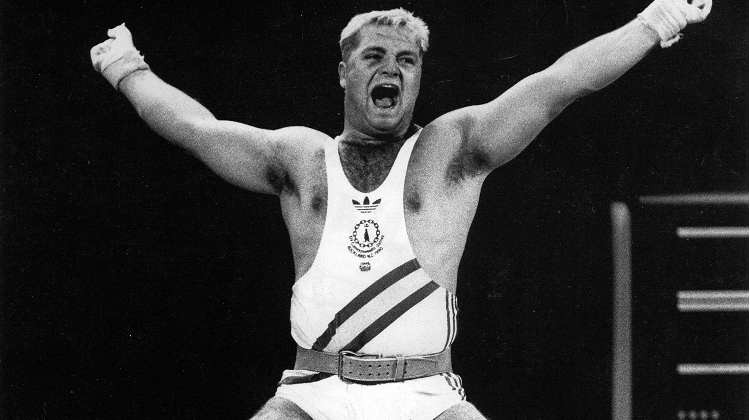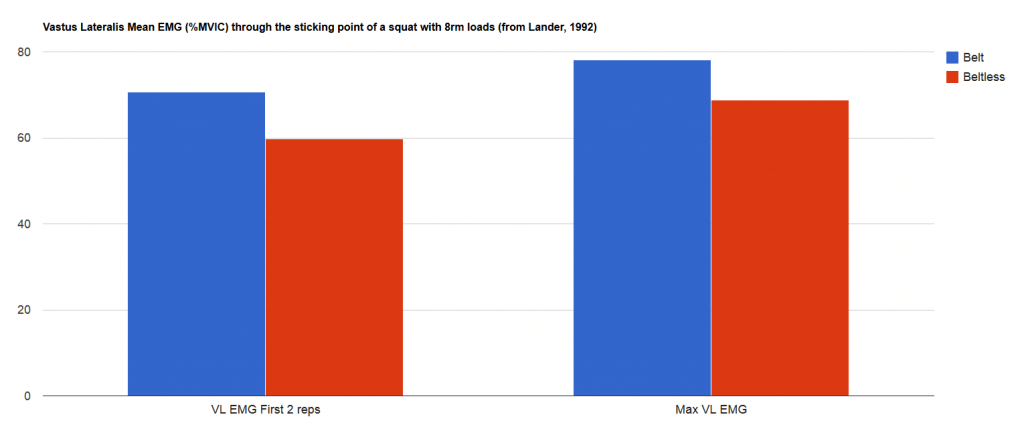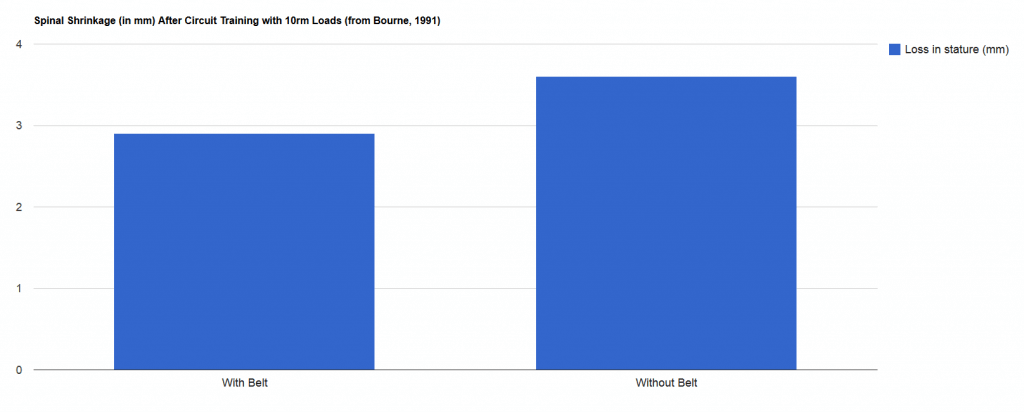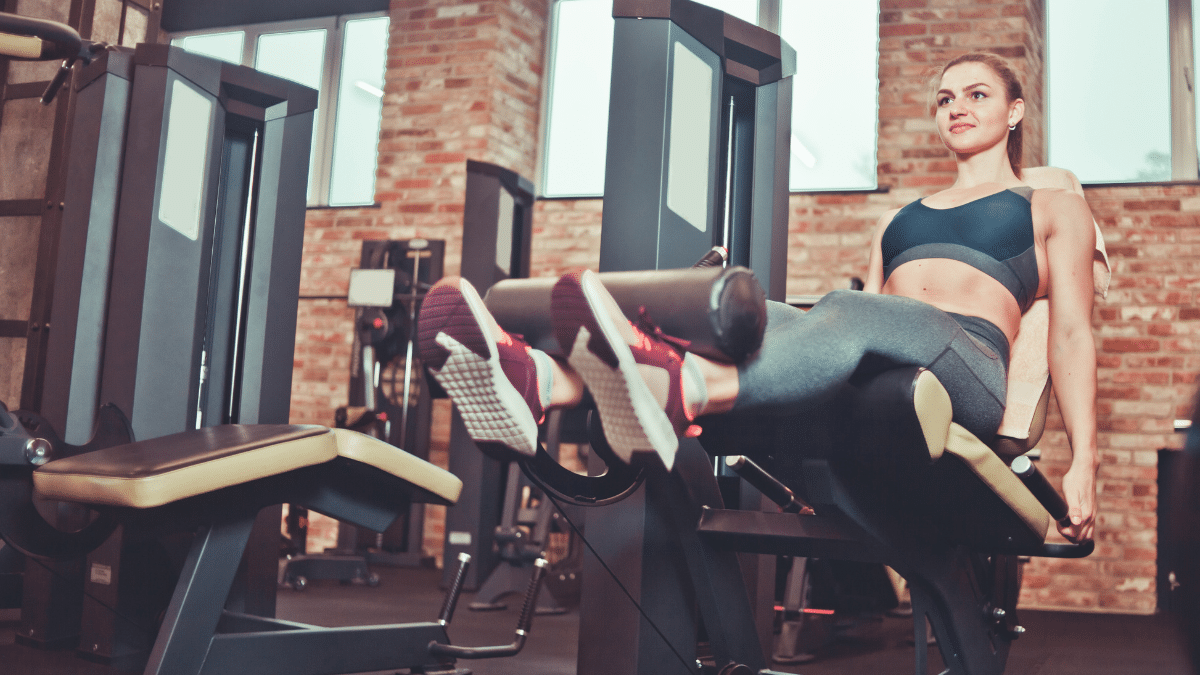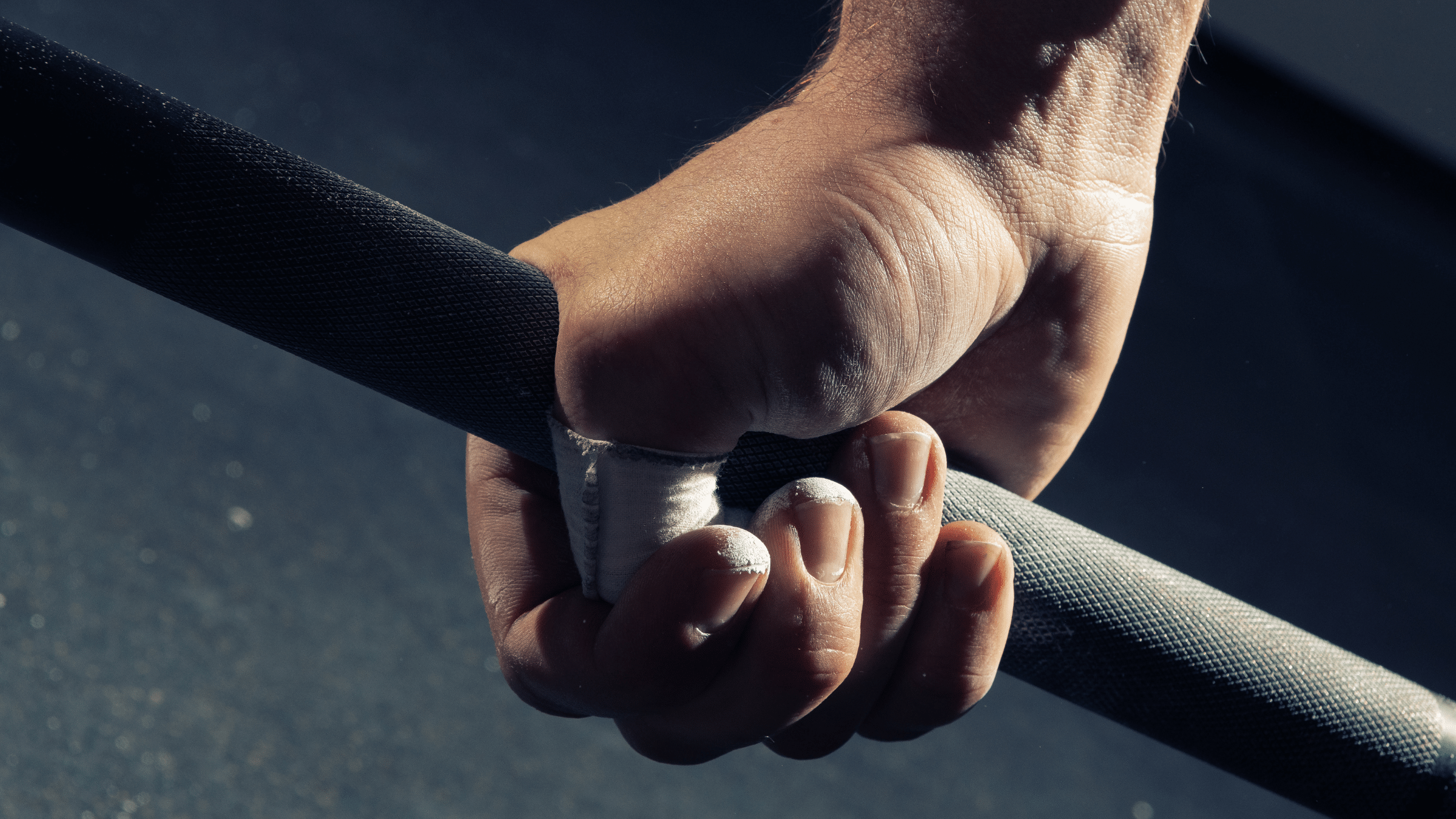What you’re getting yourself into:
~4700 words, 15-18 minute read time
This is almost certainly the most thorough article on the web about the effects, benefits, and drawbacks of training with a belt.
Key Points
1) Wearing a belt improves your performance in the gym
2) These performance increases likely mean increased size and strength in the long run
3) There are still instances that it’s better to train beltless, but you should probably use a belt for the bulk of your training
Whether or not you should wear a lifting belt is a surprisingly contentious subject. Some people are adamant that you should always wear a belt with the opinion they dramatically decrease your injury risk. Other people are adamant that you should never wear a belt, either because they think “it makes your core weak,” or because they think it’s a truer test of strength to see what you can lift without any external aid (though this article won’t be touching on that. I just see that as a matter of personal preference and is, therefore, totally irrelevant for general recommendations).
So, how much of that is true? Do belts make you safer? Do belts make your core weaker? This article is meant to answer those questions and explain the effects of a wearing a belt in quite a bit of detail.
Performance
First, it should be a no-brainer that wearing a belt *generally* improves performance. Yes, you can find examples of people lifting huge weights without a belt (like Konstantin Konstantinovs pulling 939 or Victor Naylekin squatting 903), but 99 people out of 100 can lift more with a belt than without one. I’m not entirely sure why you’d compete in powerlifting without a belt (if you compete to put up the highest possible total within the bounds of the rules, not just to improve on your past total based on your own standards). It’s hard to put a number on precisely how much more people can lift with a belt, but it seems to be at least 5-15% for most people who are accustomed to wearing a belt.
However, there is a learning curve for most people. Some people throw on a belt for the first time and hit PRs, but it usually takes people at least a few session to learn how to use it properly. In fact, one study utilizing maximal isometric lifting (one back-dominant lift and one leg-dominant lift) found that people totally new to belt usage didn’t have any increase in maximal force or intraabdominal pressure.
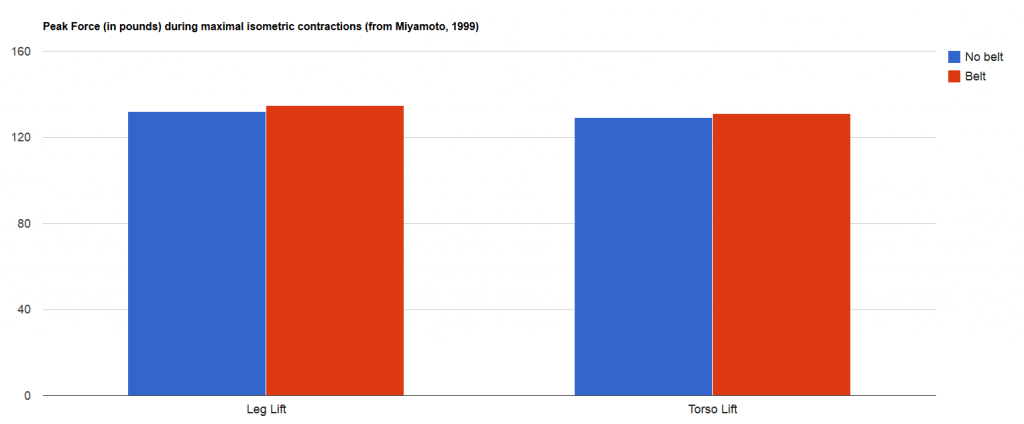
Bar speed
Several studies have found that people complete lifts faster with a belt versus without one. Now, this should also be obvious. There’s a pretty tight relationship between bar speed and percentage of your 1rm. Since you can generally lift more with a belt, then obviously you should be able to lift any given weight faster when wearing a belt.
To illustrate, one study using 90% of experienced lifters’ (average 1rm of ~315lbs) beltless max deadlift found that people reached peak ground reaction force about .3 seconds sooner in the lift when wearing a belt – they’re able to generate maximum force quicker as the bar breaks the floor. Although total time to lift completion wasn’t affected in this study, other studies have shown that people tend to be weakest in the deadlift from off the floor to just below the knee, so it’s reasonable to assume the people wearing a belt “let up” at the top of the lift (unless you’re going to contend that wearing a belt makes lockout harder).
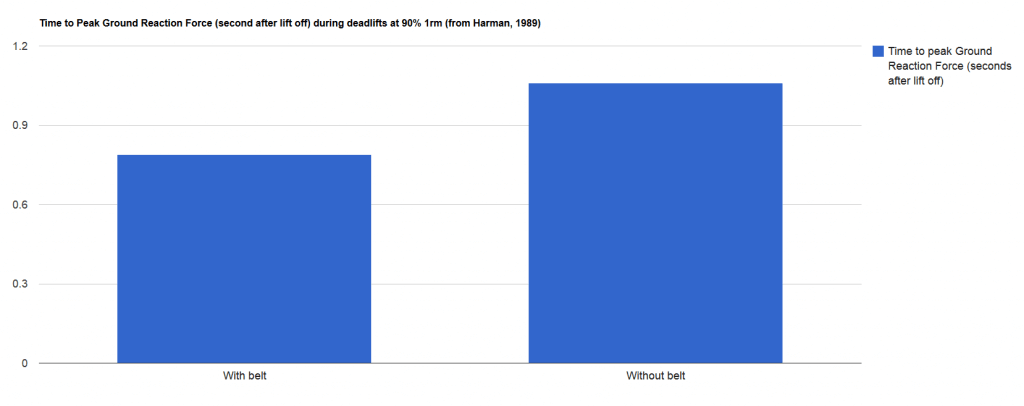
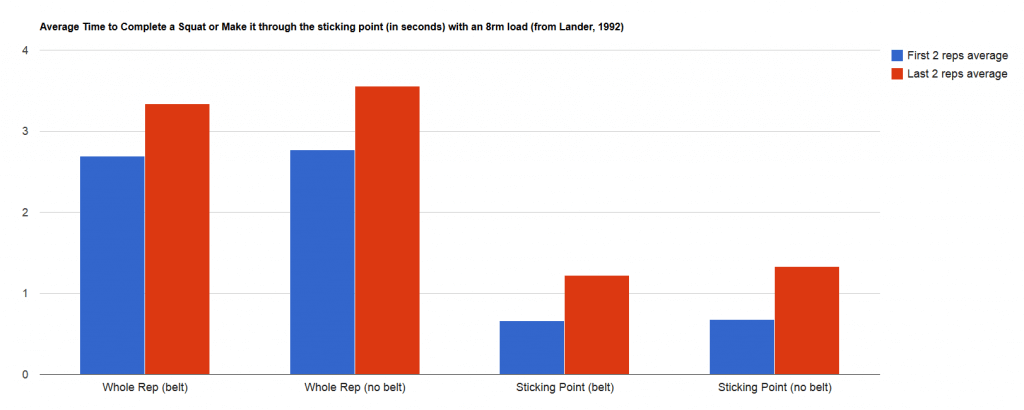
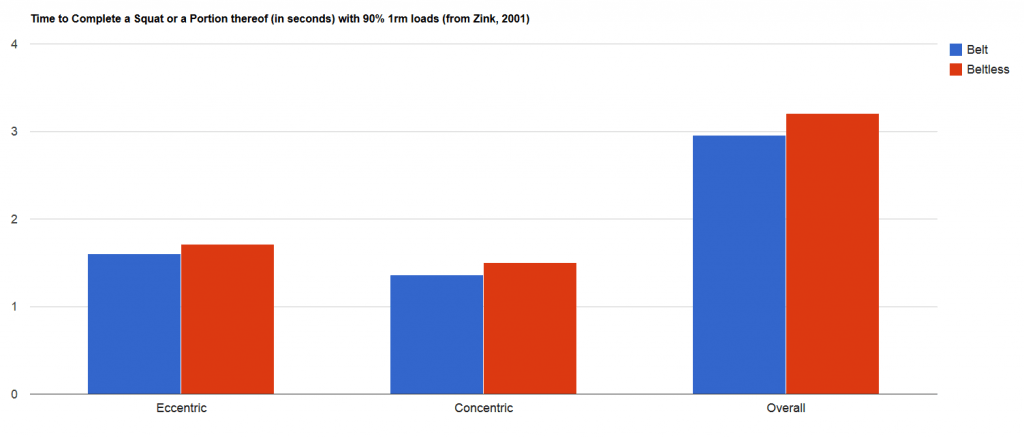
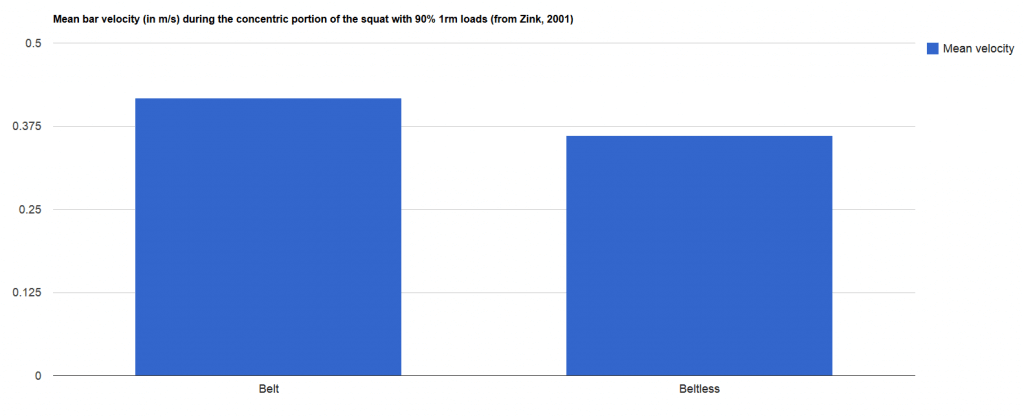
Increased reps with any absolute load
This is another benefit of wearing a belt that should be obvious. However, I just want to briefly spell out why it’s important.
All other things being equal (same exercises, same ROM, etc.), the two most important factors influencing training adaptations (aka strength and mass gains) are training volume and intensity. With a belt, you can either move 5-15% more weight for the same sets and reps, move the same weight for an extra 1-3 reps per set, or move the same weight for the same number of reps with less effort. Those are all good things that add up to more strength and size for your prime movers (essentially your leg, hip, and back musculature) over time.
Training effect
To my knowledge, there haven’t been any studies conducted comparing one group of people training with a belt to another training without a belt for a prolonged period of time. This is a major gap in the literature I’ll talk about more later. Because of this, we have to make some assumptions about how well EMG data can be extrapolated into long-term training effects. Luckily, there’s good reason to believe that EMG is a reliable predictor of long-term training effect for biomechanically similar movements (which certainly applies here, because there’s not a ton of difference between a squat or deadlift with a belt or without). If you want to know more about EMG, I’d highly recommend this (incredibly thorough) article, but that’s not a rabbit hole worth going down in this article.
Also, just a note about the studies in this section: the weights used were the same when wearing a belt vs. not wearing one, so the findings are comparing relatively easier belted lifts to relatively harder beltless lifts. In all likelihood, the EMG readings when wearing a belt would be slightly higher if they were comparing the same relative intensity (i.e. 90% of a beltless 1rm vs. 90% of a beltled 1rm) rather than the same absolute intensity (i.e. 90% of a beltless 1rm either wearing a belt or not wearing one).
Spinal Erectors
Data is somewhat mixed regarding EMG activity in the spinal erectors.
Starting with deadlifts, one study utilizing experienced lifters (deadlift max of at least 1.5x bodyweight) found that iliocostalis lumbourum (a spinal erector muscle) activation was 15-20% lower when wearing a belt. However, the load chosen for the study was 75% of the lifters’ body weight, or at most 50% of their max.
Another utilizing a maximal isometric back-dominant lift in untrained people found 17% higher spinal erector EMG activity when using a belt.
Finally, another study utilizing deadlifts with 12rm (70-75% 1rm) loads in Division 1-A football players found no significant differences in spinal erector EMG activity.
So, taken as a whole, there’s at most a 20% swing either way, but in the study utilizing the most relevant protocol, (12rm loads in D-1 football players) there was no significant difference.
Moving on to squats, one study utilizing a maximal isometric leg-dominant lift in untrained people found 18% higher spinal erector EMG activity when using a belt.
Another utilizing squats with 60% 1rm found 23% higher EMG activity in the spinal erectors when wearing a belt.
Finally, two studies with well-trained subjects (8rm squat of at least 125.5kg or 1.6x bodyweight in one, and 1rm of 156kg and 1.8x bodyweight in the other) found no meaningful difference between spinal erector EMG activity when squatting with or without a belt with an 8rm load or a 90% 1rm load, while one found a small decrease when squatting a 90% load with a belt.
So, taken as a whole, wearing a belt when squatting may increase spinal erector EMG activity slightly in untrained subjects or with light loads, but for well-trained people squatting heavy loads, there’s probably no meaningful difference.
Legs
Starting with deadlifts, the study on D-1 football players with 12rm loads found no significant differences in quad, hamstrings, adductors, or gluteus maximus EMG activity. I’m not aware of any other studies on deadlifts looking at EMG activity for the leg or hip muscles.
For squats, we have two studies, both with well-trained subjects.
One of them (sets of 8 with an 8rm load) found greater vastus lateralis (a quad muscle) activation through the sticking point of the squat when wearing a belt, and a greater increase in hamstring activation as the set progressed when wearing a belt. (If this study sounds familiar, it’s probably because I discussed it in depth previously here.)
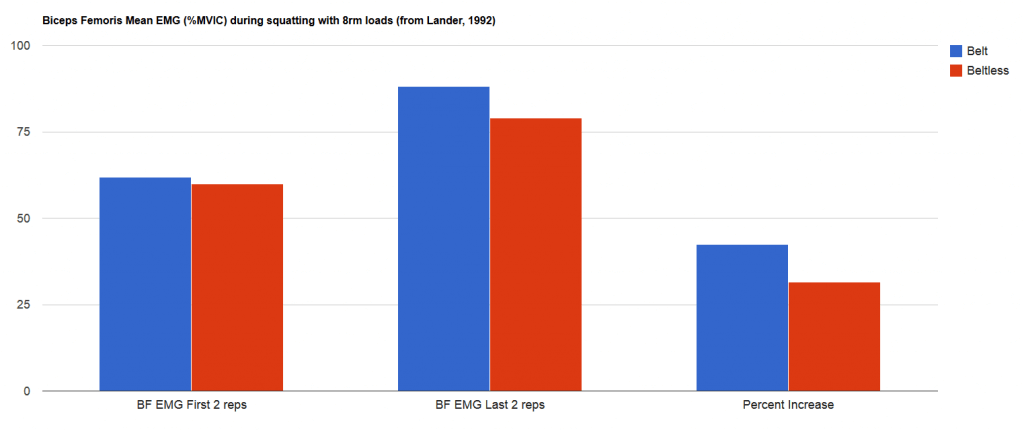
The reason for the different findings for the quads may be that the first study broke the concentric portion of the lift into thirds (out of the hole, through the sticking point, and finishing the lift), whereas the second simply looked at average EMG for the entire concentric portion of the lift. In the first, there was no significant difference in vastus lateralis activation when looking at the entire concentric portion of the lift as a whole, but the difference was evident when specifically looking at the sticking point (where it matters most).
Interestingly, the second study also measured front-to-back bar motion and found that there tends to be about 26% more when wearing a belt. People tend to shift their weight slightly more forward when wearing a belt, perhaps allowing their quads to give them more assistance through the sticking point of the lift, without affecting activation of posterior chain musculature.
The reason for the different findings for the hamstrings may be that the first study (squatting 8 reps with 8rm loads) allowed the participants to fatigue as the set progressed, whereas the second study (one rep with 90% 1rm) didn’t. In the first study, there was no difference in biceps femoris activation for the first two reps of the set, but as biceps femoris activation increased as the set wore on, it increased to a greater degree in the group wearing the belt.
The reason for the increased hamstrings activation as the set wore on is probably largely attributable to fatigue. As the set progressed, forward lean increased by about 5 degrees. As the prime movers (quads, glutes, adductor magnus) fatigued, the lifters had to rely more on their hamstrings, a muscle group typically used primarily to transfer force between the knee and hip, not as a prime mover itself. The reason biceps femoris activation may have increased to a greater degree when wearing a belt is that your nervous system’s top priority is to not snap your spine. The hamstrings pull the pelvis toward posterior tilt, and thus the lumbar spine into flexion. With higher intraabdominal pressure when wearing a belt decreasing shear stress on the spine and stabilizing the pelvis, it may be that the nervous system is more apt to “allow” the hamstrings to contract harder since the top priority (protecting the spine) is taken care of.
So, to sum up this section, wearing a belt doesn’t affect the prime movers in the deadlift. In the squat, wearing a belt may increase quad activation through the sticking point and may increase hamstring activation to a greater degree on the last few reps of a tough set, but probably not when doing singles or doing sets stopped well shy of failure.
Abdominals
This is the piece most people have probably been waiting for, since the common objection is that “belts make your core weak.”
Starting with the deadlift, one study utilizing a maximal isometric back-dominant lift in untrained people found slight (nonsignificant) increases in rectus abdominis (“six pack”) activity and decreases in external oblique activation when wearing a belt.
Another study utilizing D-1 football players lifting 12rm loads had the same findings, except that the differences did reach significance.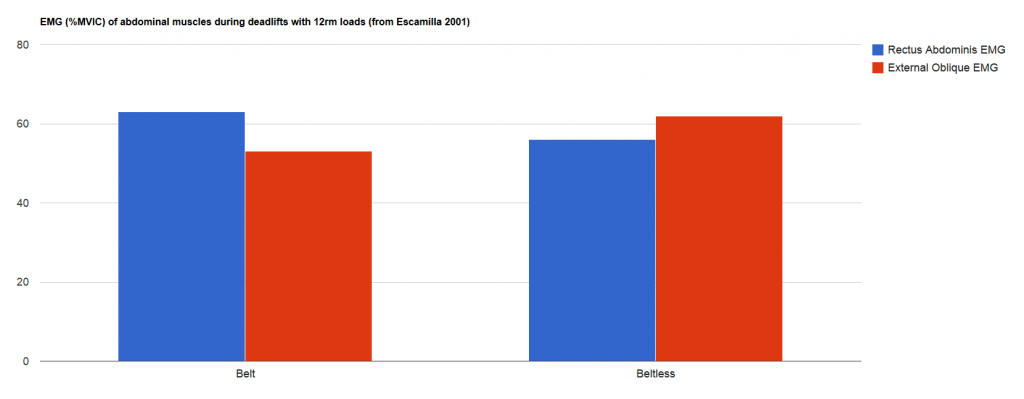
Moving on to the squat, one study utilizing a maximal isometric leg-dominant lift in untrained people found significantly (54%) higher rectus abdominis activity, and slightly (14%, nonsignificant) lower external oblique activation when wearing a belt.
Two studies in well-trained lifters (lifting 8rm loads or 90% 1rm loads) found no significant differences in external oblique activation.
So, taken as a whole, wearing a belt may increase rectus abdominis activation (although, to be honest, I’m not going to put a ton of faith in a single study on untrained lifters performing an isometric lift) and probably doesn’t affect external oblique activation.
It is very unlikely that squatting and deadlift with a belt “makes your core weak” or hinders gains in torso strength.
Safety
First and foremost, it’s really hard to say how wearing a belt affects injury risk in a gym setting because, to the best of my knowledge, no studies have been done on that subject, even though the majority of gym-goers who wear a belt say they do so for safety reasons rather than performance reasons. There have been quite a few studies conducted in industrial workers who regularly have to lift and move heavy objects. They tend to find no effect or small benefit, although some suggest that the main benefit is decreased risk of re-injury in people who had been previously injured, with no benefit to people who had never had a back injury, or even an increased injury risk when they stopped using a belt.
Dr. Stuart McGill, a (or the) foremost expert on spinal biomechanics, recommends against the use of a belt in most cases, even for lifters. He states that to get the maximum effect out of a belt, it requires spinal flexion to take advantage of “elastic recoil of a bent torso that is stiffened with a belt. However, if a neutral spine is preserved throughout the lift, this effect is minimal. In other words, to obtain the maximal effect from a belt, the lifter must lift poorly and in a way that exposed the back to a much higher risk of injury!” (emphasis his).
Now, at the risk of overstepping my bounds (because he’s Dr. McGill and I’m not), I’m not entirely sure I buy that explanation. I don’t see many competitive lifters purposefully allowing spinal flexion (especially in the squat), but you’d be hard-pressed to find many who can’t lift at least 5-10% more with a belt. That’s because there’s more to the performance benefits of wearing a belt than simply elastic recoil from a flexed torso, as we’ve already seen.
So, with Dr. McGill’s trepidation in mind (which I certainly take very seriously, though I don’t entirely agree with it), let’s move forward.
The major effect of wearing a belt is increased intraabdominal pressure. The increase varies based on the type of belt used (a thin weightlifting-style belt may cause a smaller increase than a thicker powerlifting-style belt, though at least one study indicates there’s not meaningful difference) and the lift done. For deadlifts, wearing a belt increases IAP by about 15%, and for squats, it increases IAP by about 30%–40% more than lifting heavy weights beltless.
This increase in IAP has two major effects, one good and one bad. The good effect is that increased IAP counters shear stress on the spine. The bad effect is that increased IAP may cause a higher spike in blood pressure when lifting.
There’s some mixed data on how wearing a belt affects spinal compression. On one hand, Dr. McGill’s lab found that simply performing a valsalva maneuver increased pressure in the intervertebral discs. On the other hand, a couple of studies have measured spinal shrinkage when lifting with a belt or training beltless, and they both found that wearing a belt decreased spinal shrinkage when lifting. One of them found a ~25% difference in “trained” (but not very strong. Average 10rm squat was 61kg, for reference) subjects when doing a circuit with 10rm loads. The other found a much larger (~50%) difference, but the protocol used in the study was so bizarre I’m not sure if the results mean much for our purposes (8 sets of 20 deadlifts with 65 pounds). In the first study, participants reported significantly more discomfort (not pain) when lifting beltless, and their degree of spinal shrinkage was significantly correlated with degree of reported discomfort.
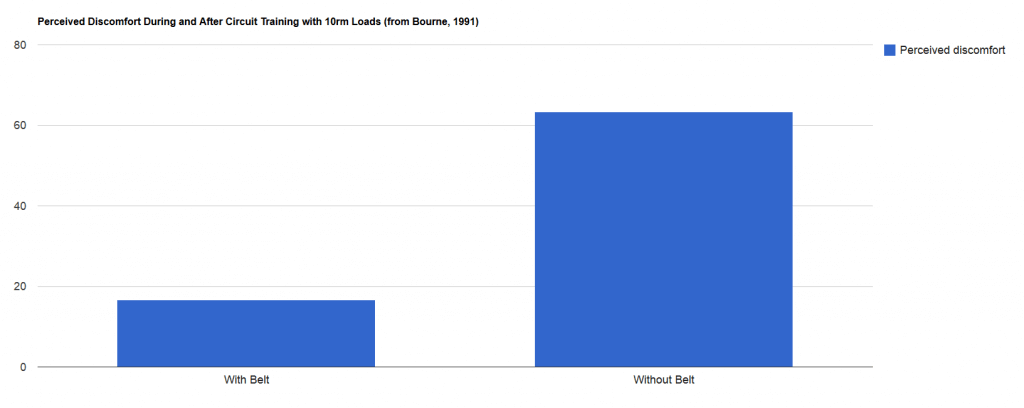
There are two things you could do with this information. The first is recommend people wear a belt if they’re more comfortable lifting with a belt. The second is to work on improving dynamic neuromuscular stabilization to improve comfort. Personally, I’m a fan of both approaches: Doing DNS work to improve comfort, but not shying away from belt usage if someone is more comfortable lifting with a belt, at least until intrinsic stabilization improves.
Limitations
The first and most obvious limitation is that there haven’t been any long-term studies done (to the best of my knowledge) comparing adaptations of training with a belt versus training without one. Although EMG data is useful, when talking about long-term training outcomes, it can only be used to discuss what will probably happen, but you should not hold any conclusions you reach with much temerity.
Another limitation is that people tend to use different bracing patterns when lifting with a belt versus lifting beltless. With a belt, the common cue is to “push out against the belt.” Since the belt doesn’t expand (hopefully), that creates intraabdominal pressure that helps stabilize the spine. Without a belt, people usually recommend taking a deep belly breath (as you would with a belt), then using the abdominal musculature to “draw in” to create intraabdominal pressure. For example, take a look at this (utterly ridiculous) beltless squat and notice how he’s clearly not pushing his stomach out the same way you would if you were wearing a belt.
These differences in bracing patterns could potentially lead to different long-term training adaptations and affect deep muscles that would be nearly impossible to pick up with EMG (unlike surface muscles such as the rectus abdominis or external oblique).
Recommendations
First, let’s talk about who shouldn’t wear a belt.
If you have blood pressure problems or issues exacerbated by blood pressure elevations, you’d probably be better of not using a belt (or the valsalva technique at all, for that matter).
If you have issues exacerbated by spikes in intraabdominal pressure (like an inguinal hernia), you’re probably better off not using a belt.
Next, who maybe shouldn’t wear a belt.
These are mainly athletes whose sport is not directly tied to how much weight they can lift. Team sports athletes, track athletes (perhaps with the exception of throwers), etc.
The argument against belt usage is that you can’t wear a belt when competing, so you shouldn’t wear a belt when training so you learn how to effectively brace without a belt.
The counterargument is that bracing of the torso is highly pattern-specific. You may not be able to brace effectively squatting or deadlifting beltless, but that really doesn’t have much bearing on how well you can brace to sprint or cut or perform any other sporting maneuvers. If you’re having issues bracing effectively for your sport, then I’d recommend more work dedicated to practicing and training those specific bracing patterns, not a general one that may not have much carryover to your sport.
Next, who should consider carefully what type of belt they get.
These are mainly weightlifters and “rotund” or short powerlifters. For weightlifters, obviously you don’t want your belt inhibiting your range of motion, because the lowest man has an advantage. For the sake of specificity, if you catch a clean deepest without a belt, I’d recommend front squatting without a belt. If you can catch a clean equally deep with a skinny belt, then by all means squat and front squat with it too. I don’t think I’ve ever seen a high-level weightlifter use a powerlifting-style belt even though the IWF rulebook actually allows a wider belt than is allowed in powerlifting (12cm vs. 10cm). Who knows, you may be the exception who can catch a lift just as deep with a thick belt, though.
For portly and/or short powerlifters, it may be prudent to get a thinner belt as well, since it’s not uncommon for a thick belt to negatively impact your starting position for the deadlift. Increased intraabdominal pressure doesn’t mean much if you’re starting the pull in a crappy position.
Finally, who should almost certainly train with a belt.
Powerlifters and bodybuilders.
All those benefits we talked about at the beginning of the article – moving more weight for the same number of reps, moving the same weight for more reps, or moving the same weight for the same reps while incurring less fatigue per set (allowing for more total volume) – you’d be a fool not to take advantage of them. Unless you have a problem with exploiting the two most potent factors for long-term strength gains (volume and intensity)… and if so, that’s your issue.
Further Considerations
So, with that in mind, what are some circumstances where it may be beneficial to train beltless?
The main one that comes to mind is when your hips or knees are feeling beaten up (not the same thing as injured), but you still want to get a good workout in while giving them a break. Training beltless naturally limits how much weight you can use, so it can be used to challenge yourself with decreased loading.
Another instance would be if there’s a very large discrepancy between your belted and beltless maxes (more than 10-15%). This could indicate that you’re using a belt as a crutch, masking poor intrinsic stabilization. In my experience, this is pretty rare and doesn’t take more than a few weeks to remedy. Again, purely anecdotal, but these tend to be people who can lift a small house, but whose back and hips tend to feel “achy” (beyond the achiness that naturally comes with lifting small houses) except when they’re lifting.
One more thing worth noting – there may be a sex difference in the effects of lifting belts. One study examined the effect of belts on oblique activation during occupational tasks (i.e. picking up and moving stuff – not lifting weights with a powerlifting-style belt) and noted a slight average decrease when wearing a belt. However, external oblique activation actually increased in 5 out of the 6 men in the study, but decreased in all 14 women. I’m not aware of any further studies investigating this difference specifically in a gym setting, so I wouldn’t worry about it too much, but it’s worth keeping in the back of your mind.
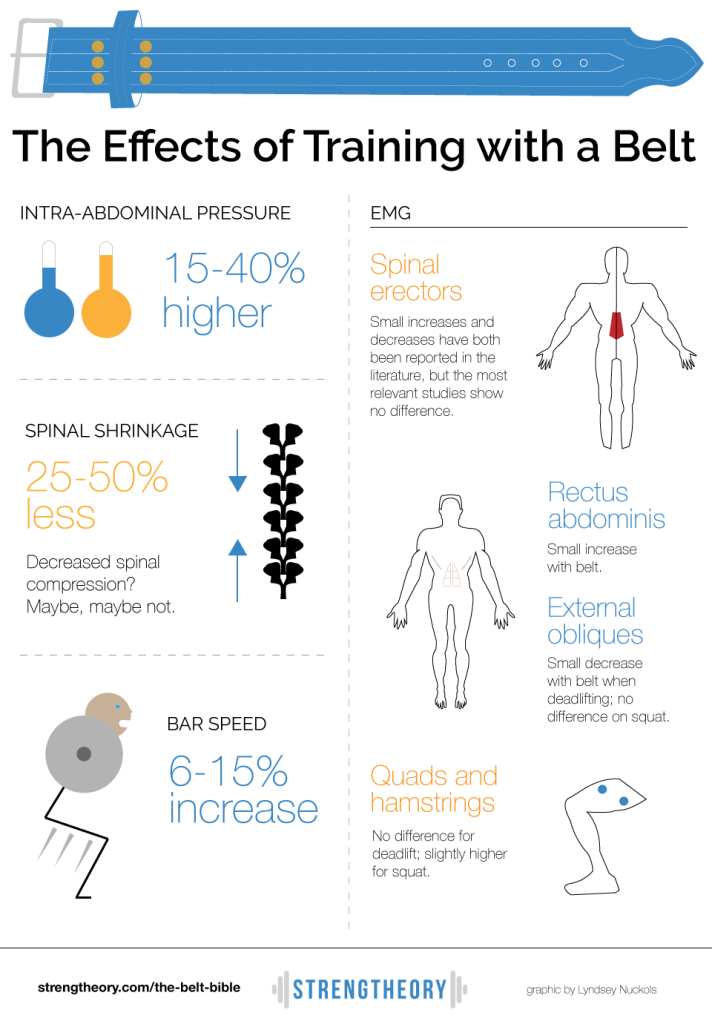
When Should You Start?
A common question that gets thrown around is “when should you start training with a belt?”
Some people throw around numbers such as being about to squat and deadlift 315 or 405, or 1.5x bodyweight, or some other arbitrary standard.
For the life of me, I can’t figure out a good reason (physiologically) someone shouldn’t start using a belt whenever the hell they want to. I do certainly agree that people should also get comfortable lifting and bracing without a belt. Again, I’m not aware of any injury data regarding belt usage in strength sports, but it seems very likely that developing and maintaining solid intrinsic stabilization patterns under load will be a good thing for spine health in the long run. However, “people should also get comfortable squatting and deadlifting beltless” and “people should never squat and deadlift with a belt until they achieve (insert arbitrary standard here)” are entirely different sentiments. I’d recommend you spend your first month or two training mostly beltless, but remember, there’s a learning curve for belts – most people can’t get much aid out of them until they’ve been lifting with a belt for a while. It’s just another skill to acquire. I’m not sure why you’d want to push that learning process back to some arbitrary later date and delay reaping the benefits that accompany training with a belt.
Personally, I’d recommend training 70/30 or 80/20 beltless your first few months in the gym, gradually transitioning to the opposite ratio as you become more experienced.
How to Use a Belt
Step 1: Setting the belt
Usually people set the belt so it’s just on top of their iliac crest. For squats, some people angle the belt up (going above the belly button), some people have it going straight across, and some people angle it down (below the belly button). For deadlifts, it’s usually either straight across or angled up (so it doesn’t interfere with getting in a good starting position, as it may if it’s angled down).
Honestly, this is more a matter of comfort than anything else. Start with it in whatever position is most comfortable. As you learn how to use it better, then you may want to play around with different heights and angles to see what allows you to get your torso the tightest.
Step 2: Find the right tightness
You should use the tightest notch that still allows for a full intake of breath. If you can’t get a full breath of air, or you have to elevate your shoulders to get a full breath instead of solely expanding your torso, it’s too tight. If you can get a full breath on one notch, but you can still get a full breath on the next tightest notch, you’re probably better off with the tighter one (at least for squats. Many people prefer one notch looser for deadlifting because it allows them to get in a better starting postion.).
Step 3: Embrace the pain
For most people, especially when using a wide (10cm) belt, bruising is almost inevitable along the top of the iliac crest as the belt presses against it. This is especially true for short people. Sometimes a fold of skin will get caught in it (especially if you’re on the portly side of things). That’s no fun at all. Using a belt, especially a 10cm leather belt that’s not broken in yet, can be uncomfortable. Either deal with it or get a narrower belt. Luckily, as your belt gets broken in better, it becomes much more comfortable and bruises you a lot less. If you take good care of it, though, it’ll last you basically forever.
What to Look for in a Powerlifting Belt
This part is pretty simple. You’ll probably do best with a 10cm wide belt for squat. If you can’t get in a good starting position for deadlift with a 10cm belt, then it may be worthwhile to invest in a belt that’s tapered in the front, or 6.35cm (2.5in) in width all the way around. Belts come in different thicknesses as well, from 9mm to 13mm. 9mm belts tend to be a little more comfortable and break in faster, but thicker belts are a little more durable, though that’s not an overly important consideration because almost any belt you get will last you a few decades.
Belts also come with either prongs or levers to latch them. Levers have the advantage of being faster to put on and remove. However, with a lever belt, you’re locked into one size and you need to use a screwdriver and take a few minutes re-adjusting your belt if the need arises, which can be inconvenient if you prefer different tightnesses for squat and deadlift, or if you engage in a little too much dietary hedonism one day and find yourself a notch more bloated than normal the next day. If you go with a prong belt, for the love of god, get a single prong belt. You may think double prong belts look cooler and more secure, but they are not more secure, and just getting one prong through one eyehole is a whole lot more convenient than getting two prongs through two eyeholes, especially if you like to cinch your belt tight.
In Closing
Get a good belt and use it, as long you don’t have any conditions exacerbated by higher-than-normal spikes in IAP and blood pressure, or are a weightlifter for whom a belt doesn’t allow you to catch a lift as deep.
As long as you don’t fall into one of those two groups, you’ll probably benefit from training with a belt most of the time.
Addendum, 2018
When this article was published way back in 2015, I was skeptical of McGill’s argument that belt usage only increased performance secondary to spinal flexion. However, I didn’t have any evidence to the contrary. However, a recent study was published showing that, under lab conditions, increased intraabdominal pressure directly increases maximal hip extension torque. Now, full disclosure, this study didn’t have people wear lifting belts to test hip extension torque. However, the most direct effect of wearing a belt is a consistent, large increase in IAP, so this study suggests that the boost in performance you get from wearing a belt is likely due to your hip extensors simply being capable of contracting harder due to more IAP.
Share this on Facebook and join in the conversation
Related Reading:
Should You Wear A Belt Or Not?
Sources:
http://www.backfitpro.com/pdf/weight_belts.pdf
http://www.ncbi.nlm.nih.gov/pmc/articles/PMC3578435/
http://www.tandfonline.com/doi/abs/10.1080/00140138708969676#preview
http://www.ncbi.nlm.nih.gov/pubmed/11411626
http://www.ncbi.nlm.nih.gov/pubmed/12930176
https://javierbutragueno.files.wordpress.com/2013/12/a-review-of-the-use-of-lifting-belts.pdf
http://www.ncbi.nlm.nih.gov/pubmed/11932579
http://www.ncbi.nlm.nih.gov/pubmed/11710410
http://www.ncbi.nlm.nih.gov/pubmed/2709981
http://www.ncbi.nlm.nih.gov/pubmed/10619094
http://www.ncbi.nlm.nih.gov/pubmed/2304406

